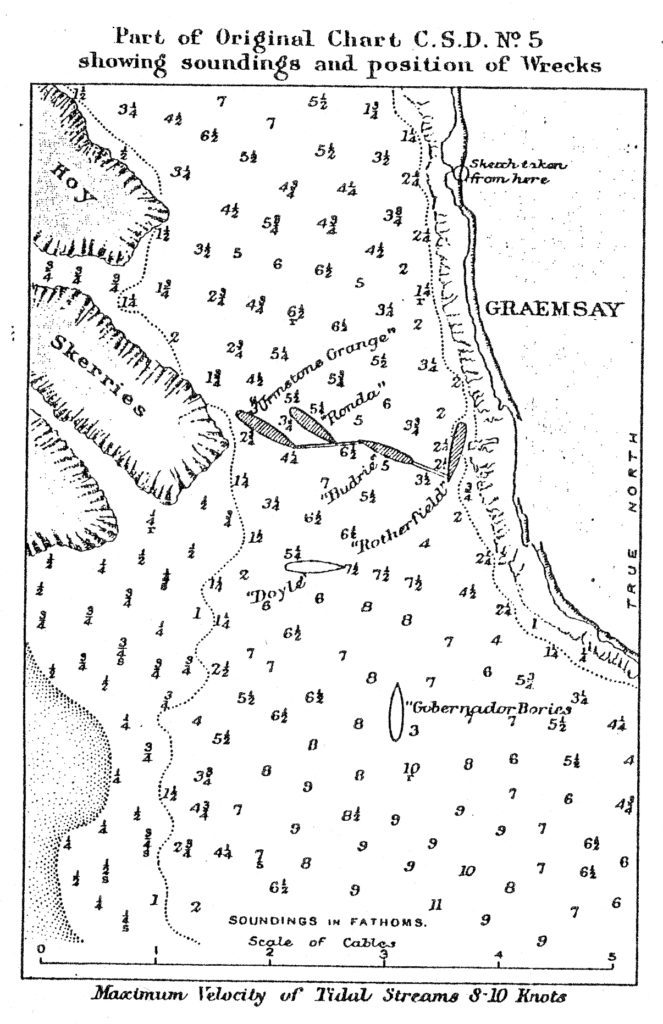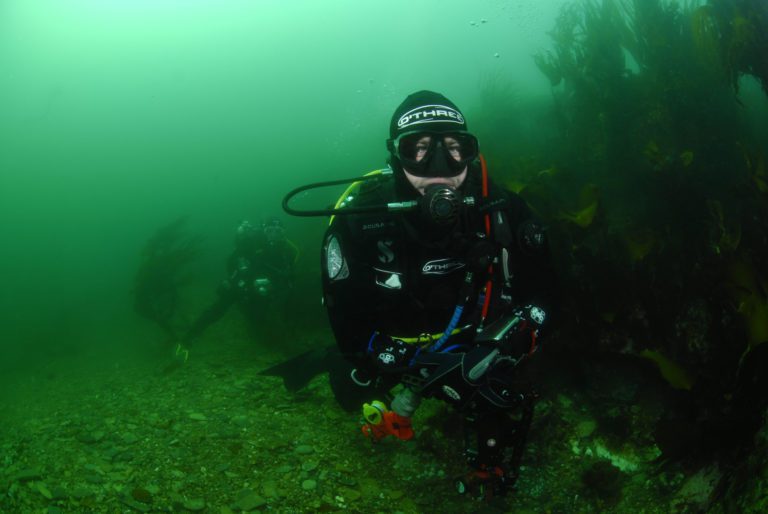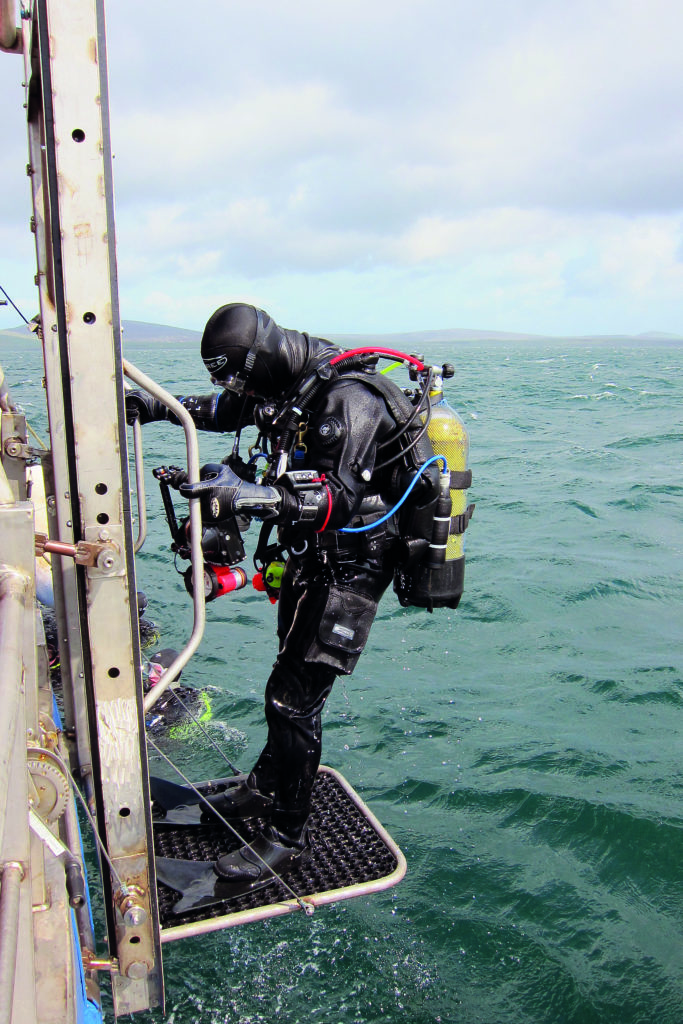Scapa Flow’s WW1 blockships offer some fantastic shallow-water dive-sites but, as LAWSON WOOD explains, one of these, the Dyle, had long been misnamed
The second edition of my Scapa Flow Dive Guide came out in 2008, but the work never actually stops once this sort of book has been published. There are always new and exciting discoveries to be made.
Also read: Divers’ new imagery lights up Scapa warships
The German High Seas Fleet was scuttled in Scapa in 1919, and the 100th anniversary edition of the guide 11 years later included new information that had come to light through the exhaustive research of Kevin Heath – and through the two of us painstakingly sifting through archival WW1 and WW2 photographs and War Department records.
For example, Kevin discovered that back in 1914, when the Admiralty was busy sinking some of the first blockships in Burra Sound, it had made a dreadful spelling error!

This is not the first time that such mistakes have happened, as I found when researching another book, Shipwrecks of The Cayman Islands. In this case a vessel that had once been referred to as the Doyle or Moyle – depending on which publication you read – was recorded as being sunk in Burra Sound in 1940, during WW2. As the Dyle, however, she had actually been sunk 26 years earlier, on 7 October, 1914.
History of the Dyle
The Dyle was built as the Widdrington in Newcastle by A Leslie & Co Engineers in 1879 for W Johnson. She was subsequently sold to Turner Brightman & Co in 1886 and finally named the Dyle after being sold to De Clerck & Van Helmeryk in 1902 and re-registered in Antwerp, Belgium.
Eventually sold to a British shipbreaker in 1914, she was acquired by the Admiralty, towed to Orkney and sunk as a blockship.
However, the Admiralty engineers had seriously under-estimated the strength and sudden change of the tidal stream. The unballasted Dyle floated off into Burra Sound before the explosive charges had blown open her hull, and she sank directly across the tidal race. The wreck was deemed useless as a blockship but, in my humble opinion, it is now quite possibly the best shallow-water dive in Scapa Flow.
The Dyle is of iron construction with five bulkheads and has a 177 nominal horsepower two-cylinder engine and one propeller. She weighed 954 tons and was 79m long. Of the three most-intact blockships in Burra Sound (the Gobernador Bories and the Tabarka are the other two), the Dyle is one of those shipwrecks that is well-suited for all levels of diver.
The dive
Accessing the wreck is entirely on the orders of the dive-boat’s skipper, and everyone on board has to be geared up and ready to go because the tidal streams are predictably unpredictable. With slack water at only around 20-30 minutes, you do have to get into the water and down the shot-line as quickly as is safely possible.
The Dyle is completely open in aspect and lies on its port side, well-embedded in the gravel seabed. The very distinctive four-bladed propeller is covered in miniature plumose anemones (Metridium senile). The timber decks are long gone, but the iron ribs and beams have created excellent swim-throughs into the sub-interior, with easy access between the ribs.
The ship remains robust enough to allow for full safe and easy access, and the interior allows you to extend your dive into the time when the current starts to run once more. Hull-plates have come away over the years, and the light now streams in through a huge number of square holes, giving the interior a rather superb cathedral-like quality.
Ballan wrasse, cuckoo wrasse and conger eels are found inside the Dyle, while and huge schools of juvenile saithe and pollack swirl around the superstructure.
The stern is also largely intact, topped with kelp and the huge prop blades are covered in anemones and small pincushion sea urchins. Once slack water passes and the relentless current starts pushing the kelp flat, divers are recommended to just drift away from the wreck (otherwise you will only pull down the dive-boat’s shotline).
Divers should deploy a delayed surface marker buoy and the boat will follow your easy progress into Burra Sound and be there to collect you.
This blockship dive is at depths of 12-17m and, spectacular in layout and covered in a multitude of marine life, meets most divers’ criteria for a superb experience. It’s also a good way to off-gas away from the considerably deeper German High Seas Battle Fleet wrecks.
WHAT YOU NEED TO KNOW
Depth: Expect to get around 12-17m (inside the lower section of the wreck and under the propeller.
Visibility and tide: This area of Burra Sound at the western entrance to Scapa Flow has very strong currents into and out of the Flow, and they can be punishing. Skippers know the exact timing of slack water before the incoming tide, because that is the only time that you can dive there.
Marine life / What to look out for: Pincushion starfish (Porania pulvillus) are always found on the wreck, as are millions of dwarf plumose anemones (Metridium senile). Cuckoo wrasse, ballan wrasse, saithe and pollack are common, as are edible crabs, scallops and squat lobsters.
Seabed: The seabed is mainly current-swept gravel and small stones and shell debris. Ship’s wreckage is dotted around, covered with plenty of seaweed and kelp.
Hazards: There is little to snag you or trap you on this wreck but care, as always, should be your priority when exploring the interior. The current is the most obvious thing to watch out for as well as lion’s mane jellyfish, which are numerous in Scapa Flow in the summer. Their stinging tentacles tend to get trapped on the shot-lines and marker buoys.
Reading: Scapa Flow Dive Guide by Lawson Wood (Aquapress)
Photographs by Lawson Wood
Also on Divernet: Pilgrimage to Scapa Flow, Scapa Flow 100: History & Wrecks, Above 18m: Wrecks Of Churchill Barrier II, Wreck Tour 134: The F2, Wreck Tour 12: The Karlsruhe



